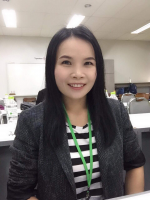โครงการวิจัย
การผลิตโคลนต้นส้มโอพันธุ์ทับทิมสยามที่ปลอดโรคด้วย เทคโนโลยีชีวภาพ
Clonal Propagation of Disease Free Pummelo cv. Taptimsiam through Biotechnology
รายละเอียดโครงการ
| ปีงบประมาณ | 2561 |
| หน่วยงานเจ้าของโครงการ | |
| ลักษณะโครงการ | โครงการใหม่ |
| ประเภทโครงการ | โครงการย่อย |
| โครงการหลัก (Master Project) | การผลิตส้มโอพันธุ์ทับทิมสยามภายใต้ความแปรปรวนของสภาพภูมิอากาศในเขตลุ่มน้ำปากพนัง จังหวัดนครศรีธรรมราช |
| ประเภทงานวิจัย | โครงการประยุกต์ |
| วันที่เริ่มโครงการวิจัย (พ.ศ.) | 1 ตุลาคม 2560 |
| วันที่สิ้นสุดโครงการวิจัย (พ.ศ.) | 1 มกราคม 2561 |
| วันที่ได้รับทุนวิจัย (พ.ศ.) | 1 มกราคม 2559 |
| ประเภททุนวิจัย | งบประมาณแผ่นดิน |
| สถานะโครงการ | สิ้นสุดโครงการ(ส่งผลผลิตเรียบร้อยแล้ว) |
| เลขที่สัญญา | |
| เป็นโครงการวิจัยที่ใช้ในการจบการศึกษา | ไม่ใช่ |
| เป็นโครงการวิจัยรับใช้สังคม | ไม่ใช่ |
| บทคัดย่อโครงการ | ส้มโอทับทิมสยามเป็นพืชที่มีความสำคัญทางเศรษฐกิจของประเทศไทย และจัดอยู่ในสกุล Citrus การขยายพันธุ์จากเพาะเลี้ยงชิ้นส่วนพืชภายในหลอดทดลองเป็นวิธีหนึ่งที่เป็นที่นิยม โดยปัจจัยที่มีผลต่อการเจริญเติบโต ได้แก่ ชิ้นส่วนพืช สารควบคุมการเจริญเติบโต และอาหารที่ใช้ในการเลี้ยง การผลิตโคลนต้นส้มโอพันธุ์ทับทิมสยามที่ปลอดโรค เริ่มจากการนำเนื้อเยื่อเจริญส่วนยอดเพาะเลี้ยงบนอาหารสูตร MS เติม BA (6-Benzyaladenine) เข้มข้น 1.5 มิลลิกรัมต่อลิตร ให้จำนวนยอดเฉลี่ยสูงที่สุด คือ 4.8 ยอดต่อชิ้นส่วน และอาหารสูตร MS เติม NAA (1-naphthylacetic acid) เข้มข้น 1 มิลลิกรัมต่อลิตรร่วมกับ BA เข้มข้น 2 มิลิกรัมต่อลิตร สามารถสร้างแคลลัสได้ 100 เปอร์เซ็นต์ ศึกษาการเสียบยอดบนต้นตอในหลอดทดลองบนต้นต้อส้ม 6 ชนิด พบว่า ต้นตอส้มโชกุนที่ทำการเสียบส้มโอทับทิมสยามมีการเข้ากันได้มากที่สุดและสร้างยอดได้สูงสุด 4.5 ยอดต่อชิ้นส่วน ศึกษาผลชนิดของอาหารที่เหมาะสมต่อการเพิ่มปริมาณยอดรวมของส้มโอทับทิมสยาม พบว่า อาหารแข็งสูตร MS เติม BA เข้มข้น 1.5 มิลลิกรัมต่อลิตร การวางเลี้ยงบนอาหารแข็งสามารถชักนำยอดได้สูงสุด 12.5 ยอดต่อชิ้นส่วน ศึกษาระดับความเข้มข้นของสารควบคุมการเจริญเติบโตและวิธีการที่เหมาะสมในการชักนำรากของต้นส้มโอทับทิมสยามในหลอดทดลอง พบว่า อาหารสูตร MS เติม NAA เข้มข้น 1.5 มิลลิกรัมต่อลิตร วางเลี้ยงในสภาพที่ไม่เติมผงถ่านให้จำนวนรากสูงสุด 5.78 รากต่อชิ้นส่วน และให้ความยาวรากสูงสุด 4.07 เซนติเมตร การอนุบาลต้นส้มโอพันธุ์ทับทิมสยามที่ได้จากการเพาะเลี้ยงเนื้อเยื่อ นำต้นส้มจุกที่เกิดรากและมีความแข็งแรงสมบูรณ์ ทำการล้างเอาอาหารวุ้นที่ติดรากออกตัดใบออกบางส่วนแล้วจุ่มแช่รากในยากันรา ปลูกต้นส้มจุกในกระถางที่มีทรายผสมขี้เถาแกลบในอัตราส่วน 1:1 ใช้ถุงพลาสติกคลุมกระถาง นำไปวางอนุบาลในเรือนเพาะชำที่มีแสงแดดประมาณ 50 เปอร์เซ็นต์เป็นเวลา 1 เดือน พบว่า ต้นส้มจุกมีอัตราการรอดชีวิต 80 เปอร์เซ็นต์ การตรวจสอบต้นส้มโอทับทิมสยามที่ได้จากการเพาะเลี้ยงเนื้อเยื่อเจริญส่วยยอดและการเสียบยอดในหลอดทดลองด้วยเทคนิค PCR/ELISA พบว่า ไพรเมอร์ที่นำมาศึกษาไม่พบการเกิดโรคบนส้มโอทับทิมสยามบนต้นตอทุกชนิด ดังนั้นการการผลิตส้มปลอดโรคด้วยเทคนิคการเพาะเลี้ยงเนื้อเยื่อเจริญส่วนยอด จึงเป็นแนวทางในการแก้ปัญหาโรคกรีนนิ่งและทริเตซ่า ด้วยเทคนิค PCR/ELISA เพื่อยืนยันว่าต้นที่ได้จากการเพาะเลี้ยงเนื้อเยื่อปลอดจากโรคก่อนนำไปปลูกในแปลงเทคนิคการเพาะเลี้ยงเนื้อเยื่อเป็นอีกแนวทางหนึ่งในการขยายต้นพันธุ์โอทับทิมสยามปลอดโรคและเป็นทางออกสำหรับเกษตรกรสวนส้มในอนาคตอีกทั้งสามารถอนุรักษ์พันธุ์ส้มโอทับทิมสยามซึ่งเป็นส้มประจำถิ่นของภาคใต้ไว้ในสภาพปลอดเชื้อและสภาพแปลงได้อีกด้วย คำสำคัญ: การผลิตโคลน, ส้มโอพันธุ์ทับทิมสยาม, ปลอดโรค, เทคโนโลยีชีวภาพ Clonal Propagation of Disease Free Pummelo cv. Taptimsiam through Biotechnology Sakulrat Hanseak1 Tassanee Khawniam2 and Tiwa Raknim1 Abstract Pummelo cv. Taptimsiam is an important economic plant in Thailand and classified in the Citrus genus. Propagation from the cultivation of plant parts within the test tube is a popular method. The factors affecting on growth are explant, plant growth regulators and culture media. The clonal propagation of disease-free began from shoot tip were culture on MS medium supplemented with BA (6-Benzyaladenine) concentration of 1.5 mg per liter gave the highest average number of shoot at 4.8 shoot per explant and MS medium supplemented with NAA (1-naphthylacetic acid) 1 mg/L and BA concentration of 2 mg per liter gave the highest callus induction at 100 percent. After that, study on 6 stocks for Taptimsiam scion and found that Shogun stock can contract and gave the highest shoot formation at 4.5 of shoots/explant. Effect of type of culture medium on shoot proliferation found that solid-MS medium supplemented with BA at concentration of 1.5 mg per liter gave the highest shoot at 12.5 shoots/explant. Study of concentration of plant growth regulators and method optimum for root induction found that MS medium supplemented with NAA at concentration of 1.5 mg per liter culture on condition without activated charcoal gave the highest number of root 5.78 roots/explant and root 4.07 centimeter. Plantlet nursery of pummelo cv. Taptimsiam derived from tissue culture by bring plantlet with root and complete strength were wash root for without agar then, dip the roots in the kantara. Planting in pots with sand, mixed with rice husk at the ratio 1: 1 using plastic bags to cover the pots and placed in the nursery at 50 percent sunlight for 1 month. It was found that the plantlet had 80 percent survival rate examination. The plantlet of pummelo cv. Taptimsiam obtained from tissue culture and top plug in vitro using PCR / ELISA technique showed that all of primer used for the study the disease did not found the disease on Taptimsiam grapefruit in all kinds of rootstock. Therefore, the production of disease-free oranges by shoot meristematic tissue technique can solving the problem of greening and tritasa with PCR/ELISA techniques in order to confirm that the plant derived from tissue culture is disease free virus before planting, it is another way to expand the disease-free orange tree and is a solution for future orange garden farmers. And can conserve varieties of pummelo cv. Taptimsiam, which is the local orange of the southern region in sterile conditions and conversion Keywords: Clonal Propagation,Pummelo cv. Taptimsiam, Disease-Free, Biotechnology 1 Faculty of Agriculture, Rajamangala University of Technology Srivijaya, Nakhon Si Thammarat Province 2 Faculty of Natural Resources, Prince of Songkla University, Songkhla Provinc |
| รายละเอียดการนำไปใช้งาน | |
| เอกสาร Final Paper(s) |
|
ทีมวิจัย

หัวหน้าโครงการ
| ที่ | นักวิจัย | หน่วยงาน | ตำแหน่งในทีม | การมีส่วนร่วม (%) |
|---|---|---|---|---|
| 1 | สกุลรัตน์ หาญศึก | คณะเกษตรศาสตร์ ราชมงคลศรีวิชัย วิทยาเขตนครศรีธรรมราช | หัวหน้าโครงการ | 80 |
| 2 | ผศ. ทิวา รักนิ่ม | คณะเกษตรศาสตร์ ราชมงคลศรีวิชัย วิทยาเขตนครศรีธรรมราช | ผู้ร่วมวิจัย | 10 |
